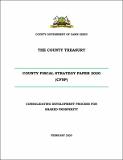| dc.description.abstract | The 11th edition of the annual Kenya Economic Report (KER) is published by
KIPPRA to fulfil its statutory obligation as set out in Part V, Section 23(3) of the KIPPRA Act 2006. Each year, KIPPRA assesses the country’s economic performance and provides medium term prospects for the next three-years. In the initial conceptualization of the report, KIPPRA holds consultative forums with stakeholders to capture issues that may require to be addressed in the report. In addition, prior to finalization of the report, KIPPRA shares the report with statutory stakeholders and other stakeholders for their views and validation. The Kenya Economic Report 2019 focuses on the strategies needed to mobilize adequate resources to help achieve the government’s development agenda. The report takes into account both international and regional development agenda such as the United Nations Sustainable Development Goals, which aim to reduce poverty in all its forms, protect the planet and ensure that all people enjoy peace and prosperity; the African Union Agenda 2063 which seeks socio-economic transformation of the continent based on inclusive growth and sustainable development; and the East African Community Vision 2050, which aims to ensure that the region optimizes the utility of its resources to narrow the gap in social well-being and productivity.The theme for the Kenya Economic Report (KER) 2019 is “Resource Mobilization for Sustainable Development of Kenya”. It explores the strategies for mobilizing resources to implement the Medium-Term Plan (MTP) III for the Kenya Vision 2030, which includes the government’s “Big Four” agenda. The agenda targets to improve the general welfare of Kenyans by creating quality employment opportunities and eventually reduce poverty levels. The report is driven by the findings in the Kenya Economic Report (KER) 2018 which identify the need to enhance resource mobilization to sustain high investments levels (30% of GDP) to achieve the desired economic growth. | en |



